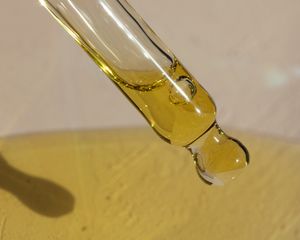
Frownies / Byrdie
When it comes to TikTok beauty advice, things can get dicey pretty quickly, with everyday people making sweeping proclamations with little to no evidence to back them up—think the viral Vitamin C tests. That’s not to say all TikTok-born beauty hacks are bad; quite the contrary. After all, who could forget Mario Dedivanovic’s viral lip liner technique or the endless tutorials on blush placement? But overall, TikTok beauty trends and advice should be taken with a grain of salt—we need to look at who is sharing this advice, why they’re sharing it, and what proof they have to back it up.
The latest trend to hit the FYP? Face taping. Yes, as in putting tape on your face either overnight or for a limited amount of time under makeup to reduce wrinkles.
It’s actually nothing new. Frownies, the most famous brand of face tape, hit the market in 1889 and has long been one of Hollywood’s oldest secrets—actress, singer, model, and international sex symbol Raquel Welch even admitted to applying them nightly in her autobiography. Meanwhile, many leading ladies have spoken of wearing face tape for events or during filming to give the skin a lifted, smoother appearance. It’s also a technique frequented by the drag community.
So what’s the deal? Is face taping the key to staying youthful or just another ill-advised social media trend? We asked the pros—board-certified dermatologists Anthony Rossi, MD, and Ranella Hirsch, MD, and board-certified plastic surgeon Raja Mohan, MD—to weigh in. Keep reading for their thoughts on face taping.
Meet the Expert
- Anthony Rossi, MD, is a board-certified dermatologist recognized internationally as a leading expert on sensitive skin.
- Raja Mohan, MD, is a Dallas-based plastic surgeon who specializes in aesthetic and reconstructive surgeries of the face, breasts, and body.
- Ranella Hirsch, MD, is a board-certified dermatologist and co-founder of Atolla.
What Is Face Taping?
Unromantically, face taping is exactly what it sounds like. Simply put, it’s a technique that claims to fight and prevent fine lines and wrinkles using strategically placed sticky tape on areas of the face. By wearing it overnight, the tape should ideally constrict muscles and limit their motion, preventing you from frowning or making other line-inducing expressions in your sleep. It’s also said to reduce and prevent lines caused by sleeping on your side and stomach. Face tape can also be used for an immediate lifting and smoothing effect—like Spanx for your face, says Hirsch.
“Face taping may not be mainstream but it's not new,” Rossi says. “From drag performers to movie stars, face taping has been used to help instantly lift the skin and disguise wrinkles in strategic places. By taping the face up in certain vectors, you can give an instant facelift effect.”
You might have seen the aforementioned Frownies in your grandmother’s medicine cabinet growing up; they’re flesh-toned face stickers that come in various shapes and sizes depending on their intended uses (a rounded triangle shape for the forehead and in between the eyes, butterfly-shaped for the corners of the eyes and mouth, and so on). Today, there are dozens of options available from brands like Furlesse, SiO Beauty, and others.
Benefits of Face Taping
Here’s the thing: All of the doctors agree that wrinkles and fine lines certainly look better when the tape is on. So using it overnight seems to be a moot point—the tape isn’t going to reduce your wrinkles. When used for an event, though, it can hide signs of aging and gives an immediate lift to the face.
But, as Mohan puts it, using face tape is similar to using makeup to cover blemishes—it’s an instant material effect, not a long-term solution or fix. If you’re looking to actually treat wrinkles, he suggests looking into laser therapy, chemical peels, and other in-office procedures.
Potential Side Effects of Face Taping
Even as a short-term, momentary solution, face tape can be fairly cumbersome. According to Rossi, it’s hard to camouflage, even with heavy makeup or a wig. Beyond that, all the doctors mentioned the potential for irritation due to the glue on the tape. And while Hirsch points out that certain materials are often used for face tape to lessen this risk, irritation is still a possibility.
And, Rossi says, repeated use can and will be irritating for most people—regardless of the tape’s materials. He also points out that if the tape is left on too long, its occlusive nature could cause clogged pores and acne from the sweat and sebum buildup.
The Final Takeaway
It’s clear that overnight face taping is fairly pointless—it does not provide any sort of permanent benefits and can really only cause irritation. The same goes for everyday use. Face tape is hard to camouflage and repeated use increases the chances of irritation.
If someone can recognize it for what it is—which, as Hirsch brilliantly puts it, is “facial Spanx” meant to temporarily improve the appearance for a big night out or for filming—it can be okay occasionally. Just remember that it is by no means whatsoever a way to treat or prevent wrinkles.
And so, the final verdict is a big fat... it’s complicated—as with most viral hacks we see online. Happy scrolling.
















